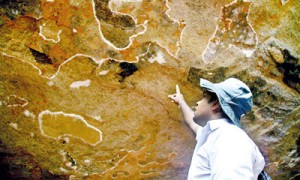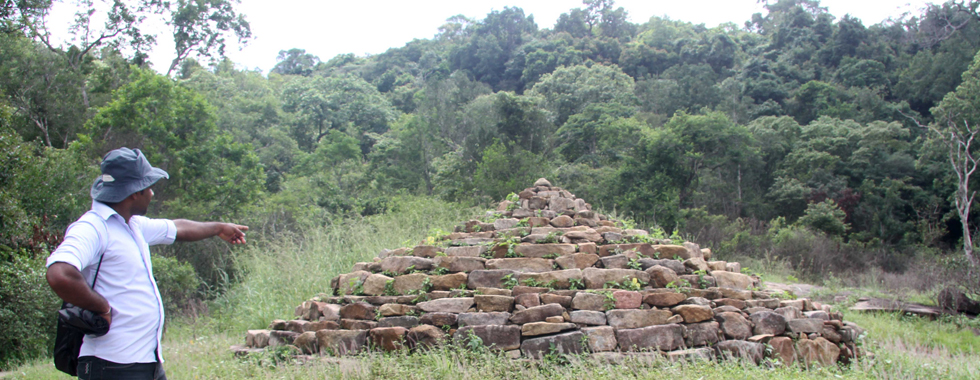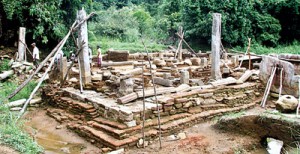Digging deep into a monastery on the mountain
A small stupa lies at the very top of the rocky surface we’re scrambling up. It sits unhindered by the verdant forest growth around it with a bird’s eye view of a large water body. A simple stone inscription by it states; “Ye imadipa patamaya idiya agatana Idika-(tera-Ma)-teraha tube” translated as, “this is the stupa of the Elder Ittiya and the Elder Mahinda, who came to this island by its foremost good fortune”. The relics of Arahat Mahinda, the first messenger of Buddhism to Sri Lanka rest here.

Faded but still visible: Cave paintings. Pix by Indika Handuwala
Our country’s story is written in stone; from the dawn of the pre-historic era, tracing its way through the early kingdoms to the advent of Buddhism, and a land and people transformed by its teachings. The Rajagala monastery, spread across a remarkable 1025 acres, and dating back 2100 years is part of this tradition.
Rajagala, or Rassagala as locals have been known to call it, is no recent archaeological find. It was discovered in the 1890s by the Department of Archaeology after the unusually high number of relics recorded in their surveys from this area. However, with more prominent historical sites to attend to, the simple monastery deep in the jungle was soon forgotten, and it was only in the early 1950s that excavation of its ruins began once more. Today the site has been entrusted to the University of Sri Jayewardenepura, which, funded generously by the state and the US Ambassador’s Fund for Cultural Preservation, has taken on the mammoth task of sweeping its many historical sites. The project is overseen by Prof. P.B. Mandawala, Prof P. Kannangara, Karunasena Hettiarachchi and Dr. K. M. Alexander.

The stupa said to contain Arahat Mahinda’s relics
Reaching the ruins is fairly easy. About 25 kilometres past the Ampara town it lies partially hidden from view until one drives through Gonagala, another well-known historical site. The mountain used to be known as ‘Girikumbhila’ by locals as it resembles a sleeping crocodile from a distance. The Sunday Times team that visited the site were taken on an exhaustive hike around the mountain by a team from the university, who have been based here since 2012.
Rajagala’s verifiable history dates back to the pre-Christian era, when Lajjatissa, son of King Saddhatissa, began building a monastery for Buddhist monks on the mountain. The Mahavamsa records that Prince Lajjatissa, who was in Digamadulla during the reign of his father, constructed a Buddhist temple on what was then known as Girikumbhila. The Mahavamsa also states that 60,000 monks participated in the temple’s consecration ceremony, and were presented with thun sivuru (three robes) by Lajjatissa.
It was when Buddhism had just begun to thrive and the kings were building their legacies in stone that Girikumbhila Viharaya, as it became known, also flourished. Prince Lajjatissa was responsible for laying the foundation stones; his wives contributed to its development and once he became king (119-109 BC) he developed the monastery further. In addition many other rulers of the Anuradhapura period, including princes, noblemen and even the ordinary people contributed to the monastery’s upkeep. Stone inscriptions (sellipi, or words carved on flat stone) found in caves and scattered around the mountain reveal the financial contributions made by laymen to the monastery’s upkeep. One records a donation of 300 Kahavanu (gold coins), a fairly significant amount that reveals the economic prosperity of those who lived in the area, says Prof. Kannangara.
One of Rajagala’s most important finds is the inscription that testifies to Arahat Mahinda’s arrival to Sri Lanka with Buddhism. The Mahavamsa states that after his death, Arahat Mahinda was cremated and several stupas were constructed to enshrine his relics around the country. One such stupa is to be found at Rajagala amidst the forest growth, with an inscription testifying to its contents. This is one of the only two such inscriptions testifying to his visit found in the country so far – the other was discovered in Mihintale.

Pieces of the puzzle: The site assumed to be the dhanashala (dining hall)
These stone inscriptions are the most concrete pieces of evidence that back up the written word, say the team. If that is the case, then Rajagala is an important testament to the Anuradhapura period. Eighty of these stone inscriptions have been found so far; some are carved into caves (len lipi) whilst others have been inscribed separately onto massive slabs of stone.
As we make the exhilarating trek up the mountain, it becomes increasingly clear why Rajagala’s monks chose a life of isolation. Equipped to meditate and even reside in, the caves – the largest of which was big enough to hold a thousand monks according to the team- form a labyrinth of rocks, distanced from the more public areas below. This meant minimum interaction with people, unless they needed drinking water or food, when they would have to head downhill towards the Rajagala Tank.
If an observation begs to be made of these caves, it would be the variety in their features. Some caves have been fortified with brick walls, enhancing their utility, and some have been equipped with air-conditioning technology in the form of a clever opening at the back. One cave in particular stands out on an elevation of its own with the stone doorway leading to it still intact, complete with a doorframe on which stone slabs perform a delicate balancing act, just as they have been laid down 2000 years ago.
Cracked cakes of plaster bearing traces of art in the caves seem to suggest the monastery was rich with culture as much as it was with religion. These paintings could have paralleled those of Sigiriya, the team speculates, but further research is needed. There may have once been resplendent hues of red, yellow and green but now there are but the merest hints of red on the walls to remind us of its ancient vibrancy.
Sound, unobtrusive architecture that gives way to the serene wilderness extends to some seemingly odd finds buried deep in the secretive foliage. Odd, because their purpose is still a mystery. Among the functioning hydraulics and intricate irrigation systems, a giant hollow stone bowl resembling a round tea cup merits a closer look. Archaeologists believe that this used to lie at the base of a small hill, collecting fresh water from a little stream for the danashala (dining hall) which could have been the ruins that lie a little further from this bowl.
The manipulation of waterways is not a novel discovery of ancient Sri Lankan prudence, but the ruins of Rajagala suggest the monastery was further equipped. The team has also come across strong evidence of plumbing.
Over 500 artefacts, including numerous clay pots, unidentified objects and carvings have so far been excavated. Faintly carved stone pillars now lying horizontally, half buried in the ground, give one a feel of the once serene yet magnificent premises.
Slightly flatter and broader than what we know today as a brick, the ancient version is in abundance throughout the site. Some have what the team describe as “modern day inscriptions” made by unruly visitors who saw it fit to literally leave their mark on history. Among them however some with ancient aesthetic carvings intact have been unearthed. Many of these inscriptions have been written in Brahmi script, believed to be the earliest stage of the evolution of the Sinhala letters.
An unfinished Buddha statue lies horizontally some distance away in a clearing. This is one of Rajagala’s more mysterious finds for the statue is elementary, its features roughly hewn into stone. Sharp lines give way to more sharp lines, believed to have been hewn by apprentice sculptors, who would usually leave the fine-tuning to their masters; in this case, the master sculptor was kept from completing the statue.
Further up the mountain lie the stupas; many have succumbed to the march of time and these have been meticulously restored by the archaeologists. Their work at Rajagala is slow, but thorough. Little is known of Rajagala’s heritage, and its eventual decline, and it has become this team’s task to unearth the facts and preserve this ancient heritage for generations to come.
Next week: The archaeologists’ story


